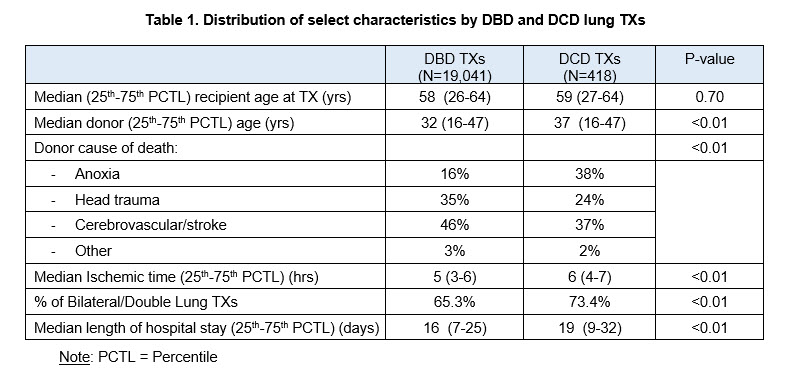Outcomes of Adult Lung Transplant Recipients of Donation after Circulatory Death Allografts in the US
1United Network for Organ Sharing, Richmond, VA, 2University of Utah School of Medicine, Salt Lake City, UT, 3University Hospitals Leuven, Leuven, Belgium
Meeting: 2019 American Transplant Congress
Abstract number: 190
Keywords: Donors, non-heart-beating, Lung, Multivariate analysis, Outcome
Session Information
Session Name: Concurrent Session: Setting the Table for Success after Lung Transplantation
Session Type: Concurrent Session
Date: Sunday, June 2, 2019
Session Time: 4:30pm-6:00pm
 Presentation Time: 5:06pm-5:18pm
Presentation Time: 5:06pm-5:18pm
Location: Room 206
*Purpose: This analysis was performed to compare outcomes of adult lung (LU) transplant (TX) recipients of donation after circulatory death (DCD) and donation after brain death (DBD) allografts in the US.
*Methods: The analysis used the Organ Procurement and Transplantation Network data for 418 adult recipients of DCD LU TXs and 19,041 DBD LU TXs performed at the same centers between 2001 and June 2017. Select characteristics were compared between DCD and DBD TXs using the Wilcoxon, chi-square, or Fisher’s exact test. Patient survival as well as freedom from bronchiolitis obliterans syndrome (BOS), treated for acute rejection, severe renal dysfunction (defined as post-TX dialysis, creatinine >2.5 mg/dl, or renal TX) were estimated using the Kaplan-Meier method and compared using the log-rank test. Cox regression analysis was used to determine the association between DCD TX and survival within 3 yrs in the presence of other characteristics.
*Results: As shown in Table 1, the median recipient age at TX was similar between DCD and DBD TXs. DCD donors were older than DBD donors. Most DCD donors died of anoxia or head trauma. A higher proportion of DCD TXs were double lung procedures and DCD TXs had a longer ischemic time than DBD transplants. Median length of hospital stay was longer in DCD than DBD TXs.
There was no significant difference in unadjusted patient survival rates (Figure 1), freedom from BOS and freedom from severe renal dysfunction between DBD and DCD TXs within 3 yrs after transplant. Rate of treatment for acute rejection within 3 yrs was higher in DBD than DCD TXs (44% vs. 37%; p=0.02).
After adjustment for differences in donor, recipient, and transplant characteristics, 3-year survival after DCD and DBD TXs was similar (p= 0.80).
*Conclusions: Although the number of DCD lung TXs performed in the US is still relatively small, post-TX outcomes within 3 yrs are comparable to DBD TXs. Rate of treatment for acute rejection within 3 yrs is lower in DCD than in DBD LU TXs. These results suggest adoption of utilization of DCD donor lungs should be further expanded.
To cite this abstract in AMA style:
Cherikh WS, Stehlik J, Sadavarte A, Raemdonck DVan. Outcomes of Adult Lung Transplant Recipients of Donation after Circulatory Death Allografts in the US [abstract]. Am J Transplant. 2019; 19 (suppl 3). https://atcmeetingabstracts.com/abstract/outcomes-of-adult-lung-transplant-recipients-of-donation-after-circulatory-death-allografts-in-the-us/. Accessed December 21, 2025.« Back to 2019 American Transplant Congress


